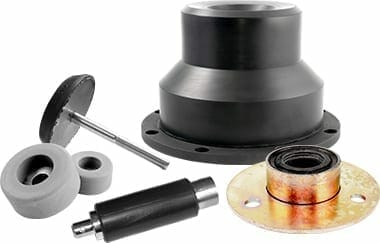Rubber Molded Products Manufacturers for Suspension Parts
Suspension Parts with Rubber to Metal Bonding
To ensure the lowest cost and high performance, rubber molded products manaufacturer Qualiform, works with it’s customers to determine the best method of rubber to metal bonding.
Custom Rubber to Metal Bonding Application
This aluminum casting is bonded to rubber with special care to ensure a perfect fit and finish. The rubber molding is a compounded formula to handle serious side deflection issues and lateral tear problems. Qualiform worked with the customer to ensure the molded rubber product met a specific durability requirement.
Our knowledgeable technical staff can assist you with product development, design and select the right rubber to metal bonding agents for the performance requirements of the application. We develop customized rubber to metal bonded solutions to meet customer requirements.
Qualiform Custom Rubber Molding creates quality custom rubber compression molding, custom transfer molding, custom rubber injection molding and rubber to metal bonding with the highest standards in customer service.

Rubber Molded Products Manufacturer Rubber to Metal Bonding Process
Utilizing injection molding and transfer molding to encapsulate and bond rubber to metal is the most effective way to adhere rubber to metal or plastic parts. Furthermore, the rubber to metal molding process provides a superior mechanical bond of rubber to metal parts, inserts or plastic parts.
Two Step Process
The process requires a two-step preparation of the metal or plastic part prior to molding the rubber. First, as rubber molded products manufacturers, we degrease and clean off any contaminants, similar to preparation for industrial coatings or painting. Once we finish cleaning, we spray a special, heat-activated adhesive onto the metal parts.
Once the part is ready for rubber overmolding, the metal parts are inserted into the mold cavity. If molding a specific area, the metal part is held in place by special magnets. If the part is to be completely encapsulated with rubber, the part is held in place with chaplet pins. The mold is then closed and the rubber molding process begins. As the elevated molding temperature cures the rubber, it also activates the adhesive forming a mechanical bonding of rubber to metal or bonding rubber to plastic. To learn more about the our bonding processes, click on the following links: rubber injection molding process or transfer molding process.


